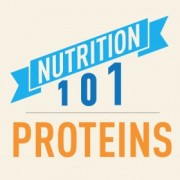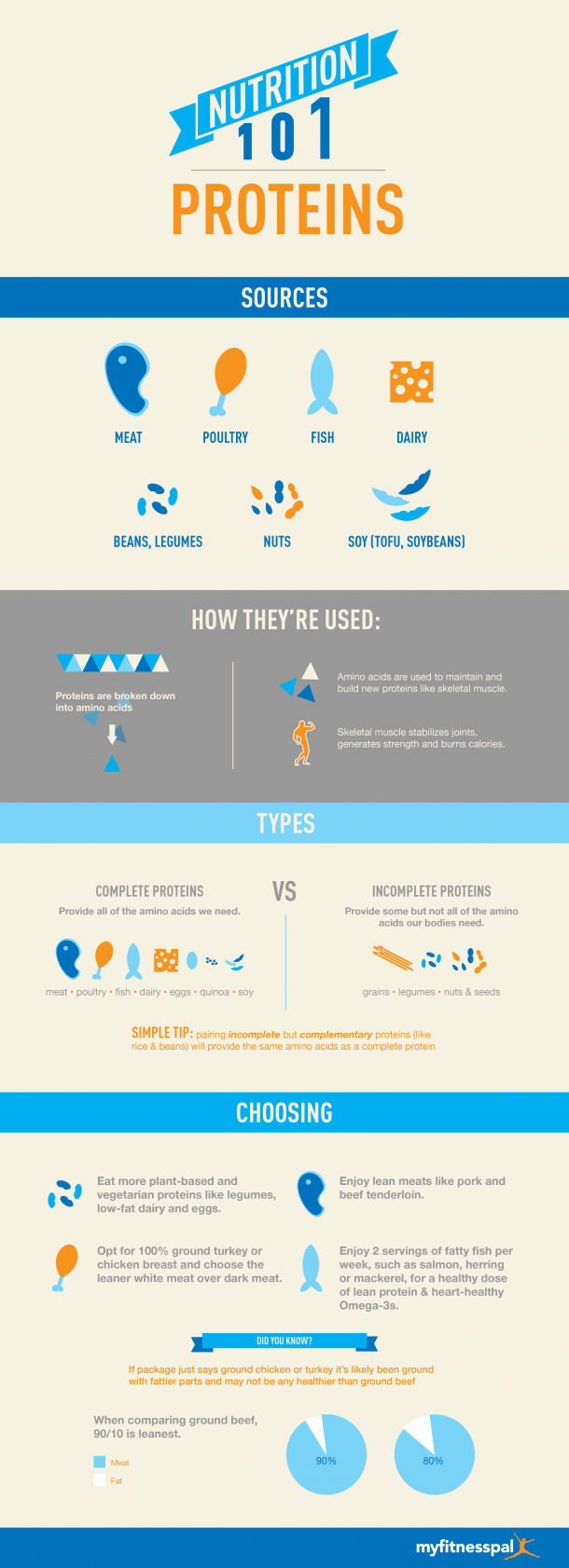Nutrition 101: Protein – INFOGRAPHIC
Whether you’re wanting to lose weight, gain muscle, recover from a tough workout, feel more satiated at mealtime or simply maintain good health, eating adequate amounts of healthy sources of protein is important.
A crucial component of every cell in the body, protein is used to build and repair tissues (like skeletal muscle, bone, hair, fingernails, cartilage, skin and blood) as well as make enzymes and hormones. Like carbohydrate and fat, protein also provides energy, but because it has so many other important functions and can’t be stored, the body relies heavily on carbohydrate and fat for energy. This leaves protein free to be used for maintaining healthy tissues, enzymes and hormones.
Shortly after a meal, proteins are digested into amino acids. These amino acids, or protein building blocks, are absorbed by the small intestine and then distributed to cells in the body. The cells take what they need and rearrange amino acids to make new proteins or repair older ones. Because the body doesn’t store protein, once our basic needs have been met, any excess is either used or stored as energy. Amino acids may be converted into glucose, and subsequently glycogen, if the body is short on carbohydrates. They may also be converted into fatty acids and stored as fat. It’s important to get enough protein throughout the day but it’s also important not to go overboard. Eating excess protein, just like carbs and fat, can lead to undesired weight gain if calories in exceed calories out.
Protein is found in a variety of foods: meat, poultry, fish, dairy, eggs, legumes, nuts, seeds, soy and even grains. From a dietary perspective, meats, poultry, fish, eggs, and soybeans are complete proteins, that is they provide all of the amino acids required by our body. Other protein foods like legumes, some nuts and seeds, and grains, don’t provide adequate amounts of the essential amino acids by themselves but can when eaten in combination with other foods and as part of a balanced diet.
So how do we make healthier choices when it comes to protein?
- Vegetarian or not, we can all benefit from eating more plant-based proteins. In addition to being great sources of protein, foods like beans, peas, quinoa and lentils, as well as low-fat dairy and eggs, are also rich in other nutrients like fiber, vitamins and minerals.
- Meat eaters, choose lean cuts like pork and beef tenderloin. A general rule of thumb when shopping: cuts that have round, chuck, or loin in the name are usually lean. Some cuts may take a bit longer to prepare (try marinating or braising) but if prepared right, they’re equally as delicious as some fattier cuts. Since ground meats are typically high in fat, look for the leaner options, like 90/10 ground beef, which contains 90% lean meat and only 10% fat. And if you’re a steak or burger-lover like I am, feel free to indulge every-so-often, but limit red meat to once or twice per week since it is high in saturated fat.
- Skin aside, poultry is generally lean–but beware when buying ground chicken or turkey. Unless it says 100% ground turkey breast (or chicken breast) on the package, the meat has likely been ground up with the skin and fat, which means that turkey burger may not be any healthier than one made from ground beef.
- If you enjoy fish, aim to eat 3-4 ounces of it twice per week. Frozen or fresh, fish can be a great source of protein. Some–like salmon–are even rich in Omega-3s, a healthy, unsaturated fat.
In addition to helping us feel satiated after a meal, dietary protein plays a critical role in every cell–building and maintaining healthy tissues and producing important enzymes and hormones that help regulate metabolism, growth and many other things. Getting enough protein is important so the body can perform all of these functions on a daily basis. But remember, just like carbs and fat, if consumed in excess, protein can just as easily be converted into and stored as fat.




